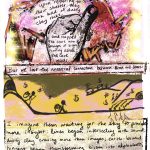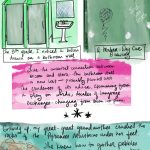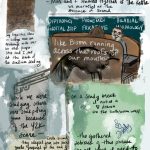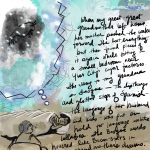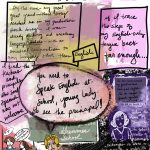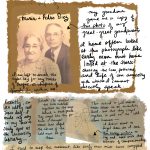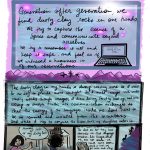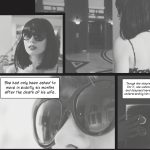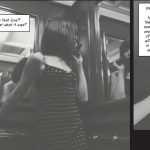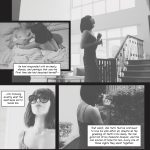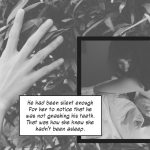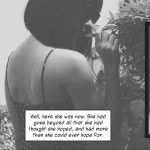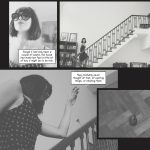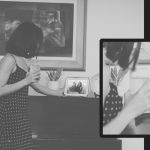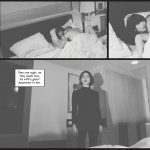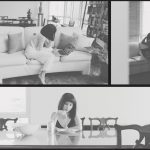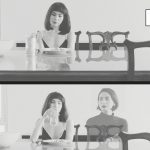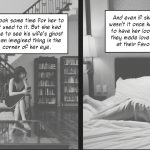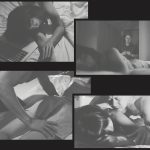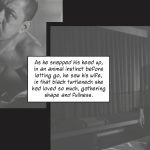Category: Aquifer
One More Game
Two Poems
Breakfast with My Spiritual Advisor at Sunny Side Café
His first job out of school was working
as a hospital chaplain at Mercy,
sat bedside with the dying
for a living, and he tells me what
it was like to wait for the joints
in their fingers to go loose like he
was letting the fish steal the hook to swim
back off into scripture with.
Out down the road
the early service releases and a ringing
tower sends off the congregation
with the old, irregular style bell
ringing that signifies to me an actual
human is somewhere down there tugging
one end of some rope that crashes
a lead tongue against the hollow insides
of cast iron. You hear that, I say,
pointing with a slice of bacon to the air,
and he says they’re an expression of joy
meant to help us forget our sadness
for a minute or so, and I say
it’s there though, pointing at my heart
with the bacon, the sadness, even
when we let ourselves forget it,
same as it’s always been,
the heartache and the thousand
natural shocks that flesh is heir to.
He says he prefers Blake
over Shakespeare any day of the week
when it comes to either sadness or joy,
To see a world in a grain of sand, he says
and a heaven in a wild flower.
When the ringing quits
I say I prefer Frank Stanford, which
is a damn lie, but I don’t tell him I actually
prefer my wife’s hair slinking down her back
though I do, or that I prefer sneaking out at night
for a cigar on the porch in early fall,
or that I’ll always prefer to bury the light
and put on the darkness like a pair of wool socks
with a hole in one of the big toes
over Milton or Jesus or Sappho.
There are houses so broken
they aren’t worth fixing, and sometimes
that’s exactly how I feel. Waterlog turned
to dryrot turned so useless you couldn’t
sink a nail. Sometimes my wife whispers
she loves me from the other room and all
I hear are bells. Other times, there’s only
a lonely wind passing through the storm door
whispering almost nothing at all.
Art Fair
I came to meander through open-air booths erected
in the name of self-taught metallurgical fiends
who curl lengths of iron into abstract lawn décor,
in the name of grade school art teachers
who scrawl feverish landscapes into the night,
in the name of potters who breathe and bellow fire
into backyard kilns, in the name of woodworkers
who turn burlwood into bowls for still-life prints.
I came here because there exist people with second lives
that last longer than the first, and because we all
eventually fall into the shapeless crowds who wander
these grassy lanes like ghosts who’ve fallen
into portraits tacked in museum galleries. If I fail
to bargain down a smear of moon oil on canvas, just watch
me move in on that bloodwood cutting board,
or that hand-twined chandelier, because there’s a price
in my head that’s incapable of change and all it takes
is a bit of small talk and to look someone in the eyes.
I once convinced a man at a roadside fireworks tent
to knock ten bucks off a 12-pack of Mississippi Gambler
mortar shells so I could paint the night with more color
than you can imagine, and he just sat back into his body
and his impossibly quiet lawn chair. Just sat back down
into a life defined by a carnival tent of powder and fuse.
Listen, I came here to feel a rougher art rush through
each one of my eye’s billion vessels, because color
and form, and because far from the Louvres
of the world artists still find ways to fashion
grief into the arcades of other people’s hearts.
Because somewhere near these tents meat smoke rises
from pork fat spit into embers, and because somewhere
there is a moveable stage upon which a bass player
slowly unlatches his case, and because soon enough
the lights of this art fair will begin to dim, and each
one of us will drift back to the silence of our homes
where we will each unearth from slumber the stud-finder
level, hammer and a single nail in order to hang
an image upon the dining room wall
where before there was nothing, until now.
Logos
The beginning of Virginia happened . . . when? That moment is lost in time. Early on, she was at the edge of my consciousness but still a writer whom, even as an English major, I had never read. Woolf wasn’t on the syllabus in any of my classes—not required reading in those days just before there were courses in feminist literature. After my graduation, I read Woolf with a vengeance. I liked the experimental novels well enough—Jacob’s Room, To the Lighthouse, The Waves—but what intrigued me most was the gradual publication of her letters and diaries.
That wealth of material gave me a window on a life radically different from my own. For a period of years, I felt as if her friends were also my friends, and that the conversations she participated in were as important to me as they were for her. It was easy to achieve this intimacy. The diaries and letters are filled with minutiae, nuanced insights, deeply personal impressions, and remembered conversations. They offer more information than most people ever reveal about their lives. The details are so extensive. It would probably be possible to chronicle Woolf’s daily life for decades.
I learned about her sister, the painter Vanessa Bell, and about Virginia’s marriage to Leonard Woolf, a Jewish writer, editor, liberal politician, and the man with whom she founded the revolutionary Hogarth Press. I was fascinated as her relationship with Vita Sackville-West unfolded, a love affair between two married women, flirtatious and communicative—resulting in the high humor and euphoria of Woolf’s novel Orlando—only to find a quieter resolution as they drifted apart.
What attracted me to Woolf? My life was completely unlike hers. I was not born into the London literati. I had my origins in a small town in northern Wisconsin. I had no famous father and no brothers at Cambridge. We definitely did not spend idyllic summers in Cornwall in a large house on the English seacoast waited on by servants, walking the beach, and playing games of cricket in the garden. My family took car trips across the American West, slogging along the interstates to see our country, camping out to save money, and eating macaroni and cheese out of a box.
I came from people whom Woolf might have dismissed or even despised and ridiculed—from farmers, mill workers, and civil servants, from those who were uneducated, at least by Woolf’s criteria. My people did not read books as a means of understanding the self, defining feelings, or interpreting the world. They worked. They were mostly just trying to survive and get by. I came from them, and yet I still wanted to be like Woolf. I wanted to write. Virginia became, at least for a decade, my higher power.
—
It’s 2006. My friend Nancy and I are touring London. I am here partly in pursuit of my mentor—Virginia Woolf. At this point, I’ve read everything she’s written. I’ve waltzed through that embarrassment of riches—the printed pages she left behind—her novels, letters, diaries, essays, and articles. Now I’m walking the streets she walked.
It’s dusk when we board the London Eye for a bird’s-eye view of the city beginning to turn on its lights. In our glass car, we rise and fall while feasting on this unparalleled view of London. Although it undoubtedly looked different in her time, this is Woolf’s city—a place she inhabited in all ways. After the ride, we choose to dine at the café in the crypt below St. Martin’s in the Fields. I order mushroom stroganoff with delicate new potatoes and a fennel salad. Nancy has a dish with steamed broccoli, cauliflower, and Savoy cabbage. Our globed glasses of white wine fracture light into the vaulted space.
It’s wonderful, yes, and isn’t this a moment Woolf might have chosen to memorialize? It seems to me I should write about it. What are we saying to one another? What are my thoughts and impressions of this day? If I don’t get this down somehow, won’t it be lost forever? I wonder. Does that really matter? Isn’t it enough that Nancy and I are here sharing this moment?
Later, I lie awake with jet lag thinking about Woolf’s second novel, Jacob’s Room. After a galloping romp through a young man’s life at Cambridge, we learn that Jacob, the protagonist, has died as a soldier in World War I. The final scene of the novel has Jacob’s mother and one of his friends cleaning out his rooms. They find Jacob’s papers strewn across his desk as though he had left for a stroll in the park.
There’s a horror in this vision, a sense of futility and emptiness. A person—vital and rich with life—is suddenly gone. The novel poses the ultimate question. What is left of all that sensation, what remains of so much rich lived experience once the person has passed? It occurs to me that, in her novels, Woolf is almost always writing toward the same end game. Yes, this is happening—this vivid and incredibly complex life tapestry. Yet, it’s also disappearing. Suddenly, because of either time or death, a chunk of it is gone, lost forever.
Woolf’s most autobiographical novel, To the Lighthouse, chronicles a family’s summer in Cornwall. But those moments are also lost. When they return to the house on the shore years later, the whole emotional tenor and tempo of their lives has changed. The mother has died, leaving them to struggle. The long-awaited trip to the lighthouse takes on a completely different meaning than it did on a day in the distant past when it was impossible to go because of bad weather.
At the novel’s end, Lily Briscoe, a peripheral character, takes center stage. She is a spinster and a Sunday painter, a woman not taken seriously by the male-dominated art world. Yet, she perseveres. Lily is at work painting the Cornwall scene when the family returns. Finally, almost giving up in frustration, unable to express the whole as she sees it, Lily declares a truce. The painting must be finished. There’s nothing more to be done. “I have had my vision,” she announces. And this seems the best we can hope for—to have that vision and attempt to record something about it even as the moment is passing.
Woolf tries to preserve those moments that don’t last, the globes of being and experience that simply disappear. She seems to be saying it’s important to celebrate the freshness, newness, and immediacy that make the world overflow. But the other side of this promise is the tragedy of time passing, the heartbreak of death and loss. I can clearly see this is Woolf’s vision. But is it mine?
After my trip to London, sick of the insistent need to turn every experience into copy, I stopped writing for five or six years. I told myself it was enough to have my experiences without constantly formulating words to describe them. It was an immense relief. My mind felt free. And yet, there must have been something of a warring voice within me because I saved my notes—notes about that day in the city and the meal I shared with Nancy. I must have believed that, one day, I would need or want them, and I did. But when I finally began to write again, it was with a different attitude. I knew I could live without writing, even without Virginia.
—
The Buddhists say that, to become enlightened, you must actually kill the Buddha, meaning you must destroy your idols. This comes from an old Zen koan attributed to the Zen Master Linji, a Chinese Zen Buddhist monk who founded the Rinzai sect of Zen Buddhism and who died in 866.
The saying says: If you meet a Buddha, kill the Buddha.
I guess I did this to Woolf after my trip to London. Not that I actually killed Virginia, but I doubted her. I saw her as a person, brilliant but limited, part of her own time, her class, and her culture. Woolf gave me a window on her world but not a passage into it. She had been my teacher, but perhaps I had learned what I needed to learn from her. She taught me to pay attention, to notice details, to hear my environment, and to listen to my own thoughts. At this realization, there was disappointment and a sense of loss. It felt a bit like losing an old friend either to death or indifference. It’s all well and good to have idols, but suddenly, I knew I would never be this person who spent three weeks touring Greece with the painter and art critic Roger Fry.
Woolf’s festival of words took me somewhere. She got me to London and enriched my time there. But in the end, I returned home, leaving England for my own geographical and personal world. My physical and spiritual home for most of my life has been the northern boreal forest of North America. It’s a place where I walk on footpaths between towering trees, a place where I count my breaths while listening for the air rush of bird wings. This is where I belong.
This winter has been a hard one. Nearby, just off the footpath, several crows feed on the remains of unidentifiable dead animal. Busily tearing toward the center of the carcass for red meat, the two companionable black birds ignore this approaching human. Likewise, a soaring red-tailed hawk offers me no greeting as it flies overhead and beyond my field of vision. As I tread my forest path, I experience the spaciousness that exists outside and beyond words.
Don’t get me wrong. I love words for their capacity to partially tame the world’s wildness. I adore them as they lean into metaphor and traverse distances. But I see their limitations. Words are temporary containment fields. I believe that, although words were her medium, Woolf understood this. She was always writing into the void, always using language to push toward the no-word zone. In novels that exist on the margins of human experience—Jacob’s Room, To the Lighthouse, The Waves—Virginia has taken me to regions where there is simply nothing more to say.
What can we know of poor Jacob after he has passed? Lives and loves succumb to time. Individuals exist for a while and then they are gone. The waves roll toward the shore, relentlessly washing away all footsteps on the beach. Eventually, through her suicide, Woolf crossed the ultimate barrier. No one could follow her into that beyond. Still, during her lifetime, Virginia returned to the place of making again and again. She tried to hold her ground even as that ground was slipping out from underneath her. She had a faith I sometimes lose. When I tire of carefully wrought language, I leave my writing desk and head into the woods seeking the place of no-words.
Entering this wordless zone is another way of killing the Buddha. But I know he isn’t really dead. I’ll be back at my computer soon enough. Tall pine trees creak in the wind. It seems that, though it is incomprehensible to me, they speak in a language all their own. And suddenly I get it. Virginia is the hawk flying away from me. She was here but she’s moved beyond my field of vision. I can’t say where she is now or what she is like. I’m not even sure what I am like, but I am resolved. I turn back on the path that will take me home. My house isn’t far away, really no distance at all.
Her Affective Labor
Dear Z: The Zygote Epistles by Diane Raptosh
Etruscan Press, 2020
Paperback, 116 pp., $17.00

Diane Raptosh is the poet of the unlikely.
Of course, any creative act in itself is rather unlikely, whether it is the cosmic creation ex nihilo in which the universe is manifested out of an accident of strong and weak forces converging and dissipating, leaving some errant subatomic particles behind to crash together for the big bang, or the simple clapping of hands, a rhythm, a disruption, a repetition. A creative act is the convergence of everything, an impossibility, which only has to happen once, and there it is: the dreamy reverb by David Roback, the breath between H. D.’s lines, the abdominal contraction before Bill T. Jones’s turns.
Over her thirty-year career, Raptosh has produced wicked, loopy, political, surrealistic, and unforgettable poetry: experimental and wild, a free-roaming poet of the Idaho sagelands. Her work leaps madly into the mud-pools of language with a child’s abandon, but with an intelligence that is hard, uncompromising, and disturbing in its own playfulness.
Dear Z: The Zygote Epistles completes Raptosh’s verse trilogy, a project nobly supported by Etruscan Press. The first in the series is American Amnesiac (2013), a book-length, ghazal-sequenced monologue spoken by a former Goldman Sachs exec, who seeks to recover his identity, to reconstitute himself as an improbable and decent citizen. In the second book, Human Directional (2016), Raptosh leaves the individual to explore the collective and atomized human consciousness via a slapdash of prose poems, exploded catalogues, and single-line jokes. In her trilogy, we are stuck in the hell-scape of an American post-capitalistic society: racist, punitive, commodified, cruel, and degrading. Yet, multi-vocal and therefore hopeful, precisely because of the fissures and fractures that occur amid all the digital noise.
With Dear Z, Raptosh brilliantly answers this world with a set of letters addressed to our pre-embryotic, single-cell existence: a single fertilized ovum, a “love speck,” which drifts down the fallopian tubes. Perhaps finding purchase on the uterine wall and becoming, and perhaps just being flushed out of the system entirely and not becoming. We will find that in Raptosh’s poems this difference matters perhaps less than we’d think.
The voice is materternal, not that of the mother but of the aunt: intimate, loving, world-weary, and transgressive. It is a voice that is fully queered and unmoored, wholly original:
Dear Zero,
Most humans evolved only once—in what’s likely
East Africa, 200,000 years ago. So don’t freak
when I shout out We share the same mama:
Mitochondrial Eve. Unlike the one in the Garden
of Eden, mtEve was not the sole woman on Earth,
but the one who made her descent into everyone.
So pray tell, teeny homunculus, as the line
from “Time of the Season” by the Zombies,
that British Invasion band, goes: Who’s your daddy?
Please know that should you come be, Big Data
will quickly conceive you as processing stream,
a more or less numeral entity—lacking internal lyric:
that giddiest hymnal. That solemn bee. The think feeling
fist that is inwit. Queerest iota, does this kind of talk
smack of hokum-humanist seething on my part?
Our shared mother mtEve was mostly a kink of statistics,
a ringing quark of a person: a true lovely, who probably
knew to venerate horses.
Here is a whirlwind of what Raptosh does so singularly well: the careening slant rhymes and punning, the clack of assonant syllables against sharp end consonants, and the driving free associations that make perfect sense. But amid all this dazzle, Raptosh is in impressive control of her material.
In this passage, she isolates “inwit,” a word she introduces in Human Directional, and a word she parses out in her essay, “Poetry is Where the Action Is”:
. . . inwit suggests the inner senses and interior sensibility: that collection of inner faculties the poet sets store by. Inwit is, by my reckoning, the very womb in which the poet thrives.
It seems to me that the entirety of Dear Z is an exceptionally crafted articulation and enactment of inwit. Indeed, one suspects it is a quality deep in our mitochondrial DNA, somewhere in our circuitry, we just know we must somehow “venerate horses.” Our capacity to engage in affective labor—to love, to imagine, to be awed, to empathize, to connect—surely comes from that first “mama” that Raptosh names.
Throughout these letters to the zygote, the speaker faithfully accepts the binary of becoming and not becoming, and she celebrates this suspended (and free-falling) state. After all, even the zygote that does “not become” has “been,” a sack of genetic coding as ancient as the first evolution.
Dear Z,
in the presence
of your latency—
that vacant shoe,
those shades
of facelessness—
let’s say
I think I feel
the sound of dots moving.
Our ancestral connections, both to the past and future generations, are but Morse code taps on our own genetic coding. We have the same mother running through us, the sound of dots moving. An un-extraordinary miracle-mirror. A tapping. Let.us.be.k.i.n.d.
Diane Raptosh gives us a speaker who possesses that womb-wisdom, who is generous and critical in her advice, especially when the news is harrowing. We have a great poet among us with commitment and daring and craft, who teases us and indulges us with her unconditioned and unconditional wisdom.
Santa Maria Novella
Florence, Italy
Outside the Santa Maria Novella basilica, I draw belief
in God for hours on a bench and local and foreign
visitors watch me watching faith. We all stare down
the church. Revisit and retrace an object
as if it can save the millennium, as if it can save me.
I am drawing to you, Love, in straight black lines
as a spectator’s wrinkles deepen. Who is on the watch
for angels and Satan as millennials take self-portraits
filtered to Beautiful for hours in front of the church?
As if to follow as if to Like as if to Share as if to Friend
as if to Capture as if to Block as if to Leak. Is this social
media faith’s purgatory? Please believe in my selves.
Inside my real body, frescoes. Frescoes and sketches of
now dead little i’s and little u’s then purportedly loving.
Love™ – a façade as flat as the green and white lines
mapping the face of the Santa Maria Novella.
All one hundred people in this square freeze
to view order for seconds and minutes and hours
and the lovers kiss and hold it as if Love’s relics
as I wonder who will be discarded upon homecoming as
if trash blown up dew-slicked streets of East Walnut Hills.
u and i kissed and held it for years
in America to peel off the monochromatic
color scheme on Satan’s dividing palette yet
my image you displayed for no one. Unaffirmed,
unshared, you ghosted me. Our love—my grave.
Behind the basilica, the sinking sun births shadow-
twins, keeps loneliness company. Couples go silently
away. Nights, I pretend to be Loved™—paint God.
Where the tour
Where the auction
Like Fireworks, Far Off
As if chrysanthemum fireworks flaring
gold, blue, red—brief, phosphorescent
amoebas throb, pulse. Next, a galaxy
of green stars spins out of existence.
Then, a flurry of supernovas
flare and fade. After, a comet-like
streaking ends in a white flash. All the while,
a far off chorus of oohs and ahs
mingles with some last applause.
Then, for a moment, it seems like dawn.
’50s Movie Stars and Hong Kong Metro Stations
Attack of the Fifty-Foot Centerfold by Dorothy Chan
Spork Press, 2018
Paperback, 103 pages, $18

Everyone deals with their own sense of identity. We’ve all experienced our own unique moments, and presenting these moments in a way that conveys the inherent emotions that lie therein can be a personal, soul-bearing thing. In Attack of the Fifty-Foot Centerfold, Dorothy Chan’s poetic protagonist talks about her life in snippets. Through tales of men the speaker has dated and meals she’s cooked with her family, we see how a Chinese-American identity was shaped, and how that affects the speaker’s everyday life in blunt, humorous poems that involve ’50s movie stars and Hong Kong metro stations.
The three sections in this book are divided by subject matter. Though everything connects because it all relates back to the narrator’s persona, the sections are split between overarching themes of family, culture, and experiences with dating and men in general. The reader is walked through these sections with a tone that feels half-sarcastic until it doesn’t. We get long lines, pop culture references in tow, that give the reader a chance to understand the speaker on a personal level. For example, when talking about attractive men, Chan writes, “… O, I don’t get wet for / the Hot Dads of US Weekly or the dad / bods of Star, but give me Frank Sinatra’s / voice crooning in a Hong Kong cab.”
The poems switch between multiple poetic forms that lean to the side of the traditional, including odes and sonnets, and yet use blunt language and modern-day references, producing a delightful whiplash in the reader. The easy way in which these verses connect with a contemporary reader makes this book a pleasure, and the book holds a similar range emotionally as well. Despite the fun nature of a lot of these poems, Chan doesn’t shy away from presenting the reader with poignant moments, such as one in which the narrator notes, “my mom tells me spirits never leave / their homes, and that we believe our loved ones / visit us in dreams about a week after they pass away, to say I love you.” Chan simultaneously opens up to the reader without presenting her cultural identity as something grim, sorrowful, or alien.
This is Chan’s second book. Her first, Chinatown Sonnets, also tackles some of the same overarching themes. What comes through most is the consideration of belonging as a concept. Chan’s narrator speaks to her parents in a mix of Cantonese and English, both languages belonging to vastly different countries and cultures. The speaker eats traditional Chinese meals with her father, but is attracted to bleached-blonde, lithe, toned surfer boys. There is a feeling of belonging to each place, but that is juxtaposed with a feeling of otherness. What exactly dictates the need to belong—or do you ever really need to belong? Chan tackles these questions by presenting her unyielding and unapologetic opinion on the subject, while also showing a complex identity can be exactly what makes a person belong. Her speaker is a loving daughter. She feels a certain sense of kinship with movie stars and musicians of the ’50s and ’60s. She still misses her childhood dog. All of these things make her unique, and she is confident in that—she belongs within herself. This exploration of the concept speaks of a time when she was not confident in this. We can all fall short—we can all question our place in society, at home and among friends. She has ruminated on this topic, and presented in a style that makes this book not only a beautiful read, but an enlightening one.
Chan accomplishes the feat of speaking about identity and belonging, and how they relate to the place one feels like they’re from—and she more than succeeded. This quick read is a gorgeous display of experimentation with poetic form and voice. The message it sends—though the words are personal to Chinese-American life—leaves the reader feeling just a little more confident about themselves, justified in the individuality and peculiarity of their own experiences, too.
Overhang
I slipped and nearly twisted my ankle getting out of bed and trying to look out the window—as if it made a difference what the weather was. The day would be wasted at work, where I would mostly sit on the edge of the toilet, zooming in to towns in Greenland and Mozambique and the Russian Far East on my phone. My boss sat in a glass-enclosed office and scrolled Reddit all day, and it was clear from the way he talked to me that he didn’t know my name. I had lost my job as a sommelier and ended up here. I used to joke that I would rather be a day laborer than one of the petty tyrants I had spent my life tiptoeing around; that way, at least, I could keep to myself. Now my wish was granted.
I didn’t really know what my job duties were, although I was able to intuit that breaking down tomato boxes, wrapping them with twine, and setting them in the lot behind the building for pickup fell to me. Around six everyone left for the day, and I would work alone in the big empty facility until my shift ended at ten. The vaulted ceilings and troweled floor magnified every tap of my feet like snare hits. I dithered, playing on my phone; now and then I broke down a box and leaned it against the wall with the others, finishing by evening’s end however many were going to get done in my dithering style. The boss probably assumed I was sweeping and mopping. What did I care?—they paid me hardly enough to live.
Improved weather lured me outside—I spent the last couple of hours of my shifts in the lot behind the facility. I dragged out however many boxes I might realistically take care of. One night I flipped one on its back and tore off its flaps. With a razor blade I’d found on a windowsill, I cut two windows and a door in the front. My shadow reached into the bath of kudzu behind the barbed-wire fence.
I tore apart several more boxes and taped them together into some sort of hut, big enough for, say, a few cats to lounge around in.
Over time, I built the structures more and more elaborately, adding lookouts and flourishes, always thinking of symmetry. I cut out crenellations. I drew out entrance halls. I realized I needed this, enjoyed this little something. One night I made what you might call a castle, with four lookouts and a full-on gatehouse. I assembled a drawbridge that didn’t quite work, and then it was already five past ten. I would have to start the whole thing over the next day. I didn’t know where the boxes actually disappeared to—some kind of processing facility, I assumed.
On Memorial Day I was one of two employees scheduled. A professional cleaning crew was brought in. Nobody told me how I should interact, so I avoided them. I hauled every box I could find outside and built a room big enough for two people to have coffee in. I brought in two folding chairs and sat and put my feet up. I wrote “Hotel Pomodoro” over the entrance with a Sharpie. I liked to think I was daring them, whoever they were, to take it away. The next day my little cafe was gone, the asphalt clean.
I was supposed to have begun getting ready for work by now. The day was bright—I stood on my balcony and came alive in the sun. I was taking the day off: I wasn’t going to show up.
—
I walked to the corner store for cigarettes. An orange tabby sat at attention beside the door, pretending not to see me. “What is this, Buckingham Palace?” I said, never having felt more unselfconscious about dishing out tepid one-liners.
I bought my pack, saluted the cashier, stripped off the plastic, and strolled out into the sunshine. The skyline soared in the foreground; it looked as if the buildings were receiving medals, the tallest in the middle taking gold. They seemed to smile at me. The possibilities of today were almost overwhelming. I could walk all the way downtown. Maybe take in a movie. Or I could buy a novel and gobble up the whole thing in the park.
I decided I would take myself out for lunch downtown at the famous place I knew only by sight where the ramen was of the highest caliber.
I had no desire to call in and invent some excuse—I didn’t owe them a thing.
Was I quitting? Was that what I was doing?
At the bus stop a man I’d never seen before was dancing joyfully, barefoot, hair swinging. He leaned out from under the overhang and held out cupped hands, still bouncing. I handed him a dollar, we dapped, and the shop cat skittered out from behind the bench and scampered up the street as if our knuckles touching had launched him.
The cat stopped at the next corner and glanced back, waiting for me.
We let a car pass and crossed the street together. I started running to see if he would follow along. He did. We jogged past the shady schoolyard; a group of kindergarteners heaved a red ball toward the heavens and squealed.
The next intersection marked with an X the “downtown” of the neighborhood, a cluster of markets and restaurants with funny names: Victory Cigarettes, Zen Tool & Hardware, and, of course, Mr. and Mrs. Fruit.
Maybe I would buy myself something nice. Once a week I almost spent my entire savings on a giant television. If I were going to die on my feet, I might as well enjoy myself.
It was just now one o’clock, my in-time. If I snuck into the facility at two, when management had their daily meeting, maybe no one would see me come in late, and I could keep my paycheck after all.
The cat, who had gone ahead while I stopped to think, looked back at me expectantly. I caught up with him.
We reached the local ramen shop, the last shop on the last strip of this section of town. I had never eaten here. I assumed it was inferior to the fancy place, which I couldn’t imagine improving upon.
I looked at the menu, even though I knew it wouldn’t do. I wanted the real deal; I wanted something to look forward to.
The cat’s eyes blazed: he was fixated on something ahead, his heart thumping through his fur. He was staring into what I called the Zone, the fenced-off moonscape of wild grass and rubble between the inferior ramen shop and actual downtown. The road we stood on bisected the rocky terrain, rising up slightly before us and vanishing down. I knew it eventually led to the overpass I considered to be the border with actual downtown, only two blocks from the ramen mecca.
At the precipice of the Zone, the wind picked up. The cat paused, his body scrunched, the formerly linear stripes down his back now scrambled. He squinted nervously. I bent down to pet him goodbye and he shied away. I tried again, and he ran and hid behind a car.
The brightness of the chalky mass and the openness of the sky were paralyzing. I forged into the headwind, shifting my gaze to the sidewalk. The glaringly white concrete stung my eyes: there was nowhere to look.
I couldn’t walk straight; I slipped off the curb and veered into the road.
I was going to get hit by a car.
I stumbled back, blindly found the fence, grabbed on. I covered my face with my other arm, slid to the ground, and curled myself into a ball.
My eyes stayed shut for some time. I watched brain TV, avoiding myself. Maybe a few minutes passed, and I then heard the gentle crunch of slowing tires, and then an engine fan. I peeked through my knees—a taxi had stopped across the street. The window, opaque with reflective glare, came down, gradually revealing a woman’s impassive face, squinting at me.
In the car I asked if she could take me to the ramen place I’d just passed, the less exciting place. Taking the bus home from downtown didn’t sound pleasant, nor did I want to shell out for cab fare from there, which would approach the cost of lunch.
She asked if I meant the restaurant fifty feet behind us; I nodded. She searched my face.
—
The door chimed as it shut behind me. Someone—a waiter—emerged from a secret door in the wall and through the opening revealed the kitchen: immense steel cauldrons of bubbling broth, white-coated cooks. A woman stood at a steel table and portioned dry noodles into plastic bags, twisted them closed, and set them aside, staring vacantly ahead. The door closed and the scene ended.
I asked the waiter if I could sit at the bar. He led me through drawn curtains to an empty room—where was the bar? He set a menu on a table in the far corner, near the kitchen.
Although I already knew what I wanted, I picked up the menu and pretended to read him my order, envisioning the creamy, six-minute egg, the concentrated, nourishing broth, and the heap of soft yellow noodles from the other, better restaurant.
He nodded and took the menu. I waited.
Finally he came through the curtain holding my bowl, set it down, and left without saying anything. The ramen swayed—pork belly, seaweed, pickled mushrooms. This was not what I’d ordered.
The waiter burst through the curtains holding a jar of candies. I lifted my chin and writhed to get his attention.
He stomped his foot, acknowledging the mistake, set the candies on the table next to mine, and carried my bowl away.
I noticed my shoulders weren’t relaxed and dropped them. It’s only food.
A few minutes later an old man wearing chef’s whites limped into the room, holding a platter heaped with scallions and bean sprouts, clearly meant for a large party that was not there. He looked lost. Sweat streamed down his face.
The confusion on his face intensified when he saw me, as if he were just now realizing the restaurant was open.
He remained in his frightened stance, knees bent, five feet away, clutching the plate, staring past me. He seemed to be looking at my ear lobe. Then he glanced back toward the kitchen, maybe for guidance. I felt the urge to say something to him—I opened my mouth—and then the curtains flew back and the server rushed in, wove around the man as if he were a tree, and set before me something resembling what I’d ordered.
The broth was lukewarm and under-seasoned. The bewildered cook now held the heap of garnishes close to his knees, his arms tiring. He watched me eat.
He shuffled over and set it next to the candies on the table beside mine and returned to the kitchen.
—
The mizzling rain would have been refreshing on a certain kind of day. Not that it bothered me—it simply coated me, like a plant. My stomach growled; I had eaten three bites of ramen.
I walked in the general direction of home. Maybe it wasn’t too late to call in. Although now I would have to explain why I hadn’t contacted them earlier, in addition to lying about my absence. Lies on lies. I burst out laughing, which almost developed into weeping. I slowed to a halt, and stood, just stood there, water droplets quivering on my chin before leaping off like skydivers. At least that was how I imagined they appeared. A black SUV whooshed by, looking important.
On the bench at the bus stop sat the man to whom I had given a dollar, and sitting to his right was the cat, in loaf-of-bread position. A matching loaf—it was even the same color—of sandwich bread rested on the man’s lap. To his left were open jars of peanut butter and jelly.
He set one piece atop the loaf of bread, which he used as a table. Then he dunked his finger in the peanut butter and smeared it on the slice, and with deft, certain strokes he did the same with the jelly. He popped out another slice, slapped it on top of the filling, handed his creation to me without looking up, and went on producing sandwiches, piling them up between his legs. Now and then he glanced up at me. Maybe he was waiting for me to start eating. The window of time in which I could have plausibly said I was saving it—saving it for the first trash can once I was out of view—had passed.
I sat beside the cat. He didn’t acknowledge me. He knew I was there and accepted my presence, squinting and smiling, the way cats do. He was completely dry and smelled like fabric softener.
“Found him in a cardboard box,” the man said. “Taking a nap.”
“What did the box look like?” I said.
“What did it look like?” he said.
“Yeah.”
“It looked like a box.”
He stood, lifted the pile of sandwiches, opened a polyester knapsack, placed them inside, cinched the drawstring, set the bag of sandwiches on the concrete, sat back down, wiped his hands on his pants, and looked off into the distance.
“Anything unusual about the box?”
He looked over at me, and then at my sandwich, as if he hadn’t heard, or maybe he had and didn’t intend to respond.
I took a small bite. No granules, no razor blades. I nodded with approval, arching my eyebrows to make sure he got the message. He snorted and shook his head wildly, as if I had insulted his family and thrown the sandwich into the street.
“Crazy over there,” he said, motioning with his head toward the Zone. “Stadium is going to change everything. If they ever build it. Gonna wipe everything out. Gonna wipe out the whole neighborhood.”
Another SUV cruised by, looking official, its black-mirror windows reflecting the three of us like mangled dough.
“There’s gonna be a casino, too,” he said. “A goddamn casino. Can you believe they approved it?”
I had no idea what he was talking about. I caught myself starting to speak, emitting a truncated, guttural sound. “Ahp.”
He assessed me, first my sneakers, then my legs and shorts, working his way up to my face.
I had another bite of the sandwich. It was delicious. The jelly was exploding with strawberry sweetness. I tilted my head back and nestled it in the bend of the Plexiglas overhang. Hundreds of beads of water constellated above me, jiggling on their own, as if they were alive; every so often one broke away, streaked down the plastic, and disappeared. I got to thinking about the last restaurant I would ever work in; in the summer we served watermelon granita in crystal glasses, which either I or a runner would pass from a silver tray to guests waiting for tables. I was the sommelier.
And then I wasn’t.
“That’s why we like you—you stick up for yourself,” the manager, Jamie, had told me as I sat down to sign my termination notice.
At the time, I didn’t think it was the end of my career. The strange thing about being blackballed is nobody tells you—you gradually figure it out on your own, to the extent you can affirm it. Nothing was stopping me from trying to break back in, technically.
I remember standing in the parlor in the early evening before the rush, empty tray under my arm as I looked through floor-to-ceiling windows onto the sidewalk, watching the uneven stream of bodies, some hurrying by, some stalling; and then a woman stopped to let her dog pee on some impatiens fenced around a tree.
The Doctor Looks at My Blood Work
Says: There are blacksmiths in your eyes.
Maybe this explains the forging.
The way I flatten heat. Bang
earth against answer until
I call it knife. Nodding to bellows
in their muddy howls. Told them
chemistry separates from slag.
I speak in gardens. Interrogate
the estrogen and her rising weeds.
From space this earth is more red
than any astronaut will speak.
In the dirt, the iron begs to be born.
I kneel before anvil and pray.
Acknowledgment
You divorce. You remarry.
You are already a father; your new wife is already a mother. She has a blooming daughter that you come to love, a daughter to whom, in time, you begin to say I love you. A daughter who later begins to occasionally reply, with no discernible pattern: Love you, too.
You write a book for people just her age—that age we think of as between. A publisher buys the book, makes plans to release it, and over the course of many disorienting months these plans unfold as promised. Along the way, you encounter the moment when you must determine how to dedicate the book, when you will choose how to acknowledge the people you will elect to thank. The task is self-indulgently benevolent. You dedicate the book to your wife, first and last. You acknowledge your parents, your teachers, your friends, the people to whom you entrusted the book long before anyone wanted to pay you for it.
You acknowledge your son, of course, who is easily named. But when you try to acknowledge your wife’s daughter, who by now has been a part of your life for years, you hesitate. She is your child. Also she is not your child. The sentiment comes easy, but what to call her does not. You contemplate at length how you will identify her role in your life, the way you will declare—in print—what you are to each other. Eventually you end up with these words:
To my daughter, for being such an excellent human being to share the world with, and for teaching me so much about being a dad.
You send these words to your editor.
The day comes when the publisher of your book prints advance copies. These copies are not final; they are still full of mistakes. You show the book to your wife’s daughter, and she thumbs swiftly through it toward the end. While you watch, she slows and reads the acknowledgments page. She sees the way you have phrased your gratitude, sees the title you have bestowed her. She says nothing. She is thirteen. You do not, at first, know what to think of her silence.
But weeks pass, the book due to be finalized any day, and you don’t forget what she didn’t say. You remember your words: my daughter, for teaching me so much about being a dad. You begin to suspect that she has said nothing not because she is thirteen, but because she is thirteen and already has a dad. Her dad is not you. And finally one night when you are already feeling melancholy, you hover at the entrance of her room before bedtime and tell her you have a question. A personal question that might feel awkward. She says, dubiously, Okay.
You ask her about the acknowledgment, if she remembers what it says. She does. You ask her if she would feel better if instead of daughter, you wrote step-daughter, because that’s what she is. You ask her if, instead of dad, you should write step-dad, because that’s what you are. She says, slowly—Maybe?—and in the weight of that word you feel a sick and swollen tide of regret: at having asked the question, at having phrased your gratitude the way you did in the first place, at taking space in this doorway at all. She tells you, because she is an excellent human being to share the world with, that what you said was sweet. But she also describes, because she is an excellent human being to share the world with, how there are competing piles of guilt whose weights she has to measure, whose burdens she must compare. If you do not make the change, she explains, there is this pile of guilt. If you do make the change, there is this other pile.
You understand her.
You understand her, and you think in that moment that maybe you will never again be asked to undertake anything so parental as this, to gift her this retraction, to express the truth not the way you want to, not the way you feel it, but rather the way she needs you to. And what she needs is to be called step-daughter.
She compromises with you, suggesting that you could at least still say Thank you for teaching me so much about being a dad. You don’t realize until later that she is doing that right now. Teaching you right this second.
Because right now she argues how important it is for people to hear the true story. They need to have things explained. They don’t like things to be unclear, and you have been unclear. Worse, you have been untruthful. You have used the word daughter.
You agree to change the word. She thanks you. And then she tells you—she is so young, she is trying so hard—that at least you will have this copy of the book, this version that still says daughter, this advance that is full of mistakes. At least you’ll have that. You agree with her, even though you have no true idea what she hopes to mean, offering you this consolation. You ache with the possibilities. You thank her for her honesty. You say I love you. She says love you too. You will say goodnight now. You will leave her to her thoughtful room. You will go and you will nurse the strange dear knife in your belly, and you will send an email to your editor with the necessary correction, and for a while you’ll be lost, already fumbling to imagine some story whose words you would never take back.
The Haunting of Memory and History
Hard Damage by Aria Aber
University of Nebraska Press, 2019
Paperback, 126 pp., $17.95

The collage of memories that make up Aria Aber’s Hard Damage, the 2019 Prairie Schooner Book Prize Winner, offers an opportunity to reckon with the undeniable fact that poetry offers a home for the past and an understanding of our relationship to history. Memory is integral to why poetry must exist. American poet Ira Sadoff tells us that “memory is required for poetry,” and what Aber does is showcase this truth along with the complexity of memory, while questioning whether “memory is a privilege.”
Hard Damage chronicles Aber’s understanding of the trauma ingrained within her familial lineage stemming from violence and suffering the family experienced in Afghanistan, as she grapples with the wounds inflicted by the political and personal remnants of history. In the poem “Family Portrait,” we get a glimpse of the microcosm of the family and how the uncovering of memory is ingrained within the familial unit. Aber writes:
Family, to me,
Is only the sweat of female secrecy
This discussion of family provides more nuance as we learn about the speaker’s mother’s political imprisonment in poems such as “Asylum” and “Can You Describe Your Years in Prison?” The aperture widens as the poems convey the inescapable reality of just how much the political is immersed in the personal or the generational:
. . . How much
of my yearly tax is spent to bomb
the dirt that birthed me?. . .
Aber challenges us to investigate a painful and violent history that begets a continued destructive present, and how these events shape the wounds that are passed down again and again through the generations. Hard Damage asks, with urgency, how living through—and with— trauma, violence, and war engages our understanding of the self, lineage, and survival. How does one live with the enveloping experience of violence? How does one access ancestral history and language? How can all of this be reclaimed?
By starting her collecting within the realm of the personal, Aber prepares us to journey into a series of enveloping worlds or sections of poetry interrogating the questions of access, history, language, and reclamation. Each world presents not only the opportunity to grapple with language but also to grapple with the reality of war. In the series of poems starting with “Rilke and I,” each poem elevates the conventions of the prose poem to discuss how we remember what has happened to us. Aber writes:
My mother let me happen to her. She let prison happen to her, simply because she believed in Women’s Rights and Afghanistan as a sovereign state. She went to prison with her little sister, and she emerged. She was, I can say now, a political prisoner. She let it happen to her; then she decided to leave her family behind, move on for love, for family, for me …
Within the poetic experience, the speaker is working to reconcile intergenerational trauma and the reality of being born after the original trauma occurred. How are we meant to grasp these memories? How do we accept that we are removed from specific traumas as individuals but are very much intertwined with the remnants of our family’s pain? Each of the worlds explored in Hard Damage offers a different understanding of the haunting nature of memory, of political violence, and the attempt to move forward. Aber’s chronicles of the historic realities of her mother’s political imprisonment, coupled with her awareness of her own privilege, creates a tapestry of the different ways that memories are consume us.
Aber’s voice is entirely her own within this collection, and yet it’s made possible by her intentions of honoring the resilience and death of her ancestors. Not only is Hard Damage a conversation with history, but it also presents a rich voice conversing with various aspects of history. From speaking to the German poet Rilke, using the etymology of German, English, and Arabic words and those of the speaker’s own family, Aber’s collection explores what we are left with when investigating the roots of our world today.
The profound attention Aber pays on the line-level to the crafting of her poems presents many opportunities to engage in the depth of moments recalled by the speaker and the intensity these moments have for the personal and the collective. In “Nostos,” the speaker notes:
In English the body is both dead
And alive, but I know the blight of grief
Has a heart and thus will love, and learn, and thusly
Learn to hate—
Ira Sadoff, in “Poetic Memory, Poetic Design,” does not simply claim that memory is needed for poetry. He asserts that “syntactical memories, gathering the emotional weight of the poem as it accrues line to line,” is needed for poetic expression. Alberto Ríos tells us that “lines are what distinguish poetry from all other art forms, and therefore they intrinsically mean something. They help us to see what makes a poem a poem.” Aber not only expresses a deep sense of care and attention on the line level but also a commitment in keeping the integrity of what a line must do in a poem.
On the line level, the poems in Hard Damage break and disrupt our own understanding In the poem, “At the Hospital, My Language,” for instance, Aber writes:
cousin with no empathy. But family
is family; the awkward shell
I harbor, crack—avian eyelids,
hospital, yolk—
These lines are not only enjambed, but media caesura allows for a break and redefinition of the language before them. Because of Aber’s syntactical construction, our understanding of family is reconstructed. It takes on multiple meanings. In Aber’s crafting of the line, she evokes multiple interpretations and provides a deepening of our understanding of the line itself and the poem as a whole. These moments of intentional meaning on the line level contribute to what I find most compelling about Aber’s collection. Hard Damage works to bridge the micro space of the line to the macro understanding of what makes poetry so altering to the reader. It is in the singular moments of surprise, redefinition, and nuance created within the line that lead us to unearth meaning.
This unearthing reveals the personal and political history that sits at the crux of the collection. Aber’s yearning to show the intricacies of the Afghanistan–US relationship, the Afghanistan–German relationship, and her own understanding of the traumas these political relationships have caused creates a collection intense in its ability to interrogate the political structures, while providing a deep sense of what it feels for a person to grieve the aftermath of violence, war, and imprisonment.
It is nearly impossible to not feel the haunting density of the memories Aber explores as we immerse ourselves further into the collection. The poems ask us to be consumed by the intricate experiences of the speaker, while also carrying the responsibility and gravity of the reality Aber exposes. An entire history cannot possibly be conveyed in a mere hundred pages, yet what Aber recounts is done with striking clarity and an acute awareness of the privilege writers have to tell a story. She says:
It is a terrible time
To be alive.
I say this with the privilege
Of being alive
We are born in the midst of past and ongoing violence. What does that mean as we reconcile our identities with the trauma rooted in our ancestry? What does it mean to be generations removed, and yet still contending with the inherited trauma of our ancestors? This collection reminds us of that undertaking. It urges us to wonder, reflect, and determine how to deal with the damage.
Interview: Jim Ray Daniels



Jim Raymond Daniels was born in Detroit, Michigan, in 1956. Since 1981, Daniels has been on the faculty of the creative writing program at Carnegie Mellon University in Pittsburgh, Pennsylvania, where he is the Thomas Stockham Baker University Professor of English. His literary works have been recognized and highlighted at Michigan State University in their Michigan Writers Series, and he has won the inaugural Brittingham Prize in Poetry in 1985 from the University of Wisconsin–Madison. He was educated at Alma College and Bowling Green State University. Daniels also collaborates with director John Rice to create films of merged media. He is the author, editor, co-editor, or scriptwriter for forty-four books and films.
The following interview took place with Jim Ray Daniels on November 18, 2017, at the Miami Book Fair. Since that time, he has published an additional collection of poetry, The Middle Ages (Red Mountain Press, 2018) and a collection of stories, The Perp Walk (Michigan State University Press, 2019), as well as co-editing Respect: The Poetry of Detroit Music (Michigan State University Press, 2019). While this interview focuses on Rowing Inland, we hope it will illuminate Daniels’s prolific output and poetic sensibility more generally.
Judith Roney for The Florida Review:
Before we talk about your collection Rowing Inland I want to get you to speak a moment on imagery. I watched the trailer for one of your films, The End Of Blessings, based on your poem of the same name.
The camera follows an African American cyclist on his weekly Sunday ride, when he regularly passes an older Italian couple sitting on their porch after church. There’s no dialogue. You concentrate on imagery, sounds, and the breathing, and you’re taking the art of poetry and putting it into film. This may sound naïve, but I was blasted by the film. I mean, we don’t expect to see these kinds of crossovers of art forms.
Jim Ray Daniels:
We know when we make these short films that we can’t expect to make any money off them. There’s been other films made of poems, and typically you’ll see the text on the screen, or the voice-over, and we were like, yeah, we’re not going do to either of those things. We want to make a work of art and do something interesting and different with the medium of film, and so we focus in on sound and imagery, which are also huge parts of poetry writing. In that way, we hope we can get across the essence of the poem.
TFR:
I love that, because when you’re introducing someone to poetry, they can feel quite intimidated They may be too concerned they might not understand poetry. In my intro to poetry classes, I show students pictures of cave paintings to stress the importance of imagery and the ancient tie we have to images. When I watched the video this morning I thought, wow, I want to use it in the classroom.
Daniels:
I’ll give you the link to the full film.
TFR:
Thank you! A film like this will help the student move away from words and worrying about the words’ meanings, to a place where they see the images and hear the rhythms, and we don’t mean perfect end-rhymes. It might spark them to pay attention to sound as they move about their world. So, tell, me, where did this idea came from? I read that you are an avid cyclist—
Daniels:
That’s correct.
TFR:
What sparked you to do this? To move from the poem to the film?
Daniels:
As a writer I try and find what’s going on beneath the surface—and in Rowing Inland, I think you see a lot of it, too, where on the surface it doesn’t seem as if you see a lot of things, or like nothing interesting is happening. So, a guy riding up a hill on his bicycle—on the surface you don’t think there’s anything going on, but there really is a lot layered in there. And, I try to write a lot about my own experiences and enthusiasms. The director—he’s my partner in these films, his name is John Rice, he’s great, he’s also a big cyclist, and he said, “Have you ever written anything about cycling? Maybe we should make a movie about cycling.” And I said, “I got this poem, ‘The End of Blessings,’” and he said, “We can do this!” It’s a short film, and it and the poem each are in three parts: You rise up the hill, the old couple’s there, you rise up the hill, the old couple is not there, he rides up the hill, and the woman is there by herself.
I gave away the ending (laughs).
TFR:
I think it’s a wonderful medium to get people to see poetry as they walk down their street, go to the local store, to see images and hear rhythm all around. Anything to get people to appreciate poetry, but I don’t have to tell you that.
Daniels:
(Laughing) No, no.
TFR:
Rowing Inland is packed with imagery, imagery of Detroit in particular, and memories of adolescence, and parents and the grandfather, the yard, and mowing grass, there’s just so much here. When you’re writing, are you back there in your mind, where you are this past self again?
Daniels:
I get transported back to those places. And it’s really exciting as a writer—as a writer yourself I’m sure you’ve experienced this, too—where suddenly the process of writing does take you back. One of things poetry does is preserves moments in time, like photographs, an emotional kind of photograph, and I like to keep track of things and go back and move forward and revisit things I’ve written about before and see them differently through the lens of the present. I guess I’ve always written a lot about Detroit, and first there was some concern I was repeating myself, but—I feel like I always bring this up, it’s my mantra—novelist Richard Price said that where you’re from is “like the zip code for your heart.” I just remind myself that no matter where I go that’s in me, that place is in me and those people are in me, and they help shape who I am today. There’s the mother lode of experiences when you’re growing up and adolescence too, though not the whole book is about that.
The other thing for me, with that book, is people say, where are you from?, and I say, well I’m, from Detroit, because it’s easy to say, and, yeah, I was born in Detroit. But we moved to Warren, Michigan, right outside Detroit when I was a young boy. And so here, in this book, I deal more with Warren, which is the city bordering Detroit, where I went to high school. People from Detroit know that Warren and Detroit are two very different places. And, it has to do with coming back to James Baldwin in a way, with race. In Jeffrey Eugenides’ book Middlesex, he has some scenes of the riots in Detroit in 1967 and he once said, “Detroit is always about race.” And I wanted to make that distinction, so the long section in the center is a series of poems that are connected called “Welcome to Warren.” I wanted to capture this place people would just drive through, because it’s so anonymous-seeming. It’s basically houses surrounded by car factories. I wanted to try to bring that place to life—even if all the houses on the street look the same, the people are all different.
TFR:
Often there’s a way you might enter a certain collection, maybe from an emotional place or a geographical place, some kind of familiarity, some commonalities, and there was so much for me to discover in this book that was familiar to me. I’m from Chicago. Chicago, Detroit—you and I grew up within a few years of each other, in the land and culture of the steel mill towns, so when I read this, I kept going “yes” and I’ve already marked, noted, and highlighted the heck out of it,
As I read, I was conscious of how you were returning “home” as poet, and I thought about how I return to Chicago in my writing, though I haven’t lived there in decades. It’s my haunt, my muse. So I’m reading about the Detroit area, I’ve been to Detroit several times, I have relatives close by, and I kept feeling how much this is a familiar place, yet it is so much more than just one place.
Daniels:
It’s funny you mention Chicago, because Chicago writer Stuart Dybeck was a huge influence on me as a writer. So Chicago was his town, and he really brought it to life in his poems and stories, he writes both, and was a influence on me as a young writer.
That’s the key to writing about place so that others beyond that place can appreciate it, and that’s where the imagery comes in. Even though somebody may not be interested in going in an auto factory, you’re going to pull them in and say, Hey! look around, There’s poetry here.
TFR:
There is, and you’ve sparked me, inspired me with images of empty factories, the steel factories, which might sound strange. Also, there were so many poems in your collection that talked about the basement, and most of us who grew up “up north” had basements—down here in Florida, we don’t have basements, but there are so many poems in Rowing Inland that refer to the basement—
Daniels:
I never thought about that! But, yeah, (laughing) the basement’s big!
TFR:
In my life, the basement was a place, is a place, that holds a lot of memories. I was so touched by these particular poems, and I think that you as poet sometimes don’t know how your work, your words, might reach a reader until the book’s been out a while and you start to hear from readers.
In writing about the basement, you also wrote “upstairs she kept the order”—speaking about your mother— and then, “Downstairs, he drove another nail in.” You bring us into this neighborhood, this home, so that much of Rowing Inland is clearly set not in the heart of the city, but in a suburb, that commonality of so many Americans. At least, that’s where the first section is; the book is organized into four sections—
You have a line in here, where you’re an adolescent where you don’t quite understand what’s going on in the adult world, and in the “eight mile,” where you have physical landscape a little removed from the city—and as a poet, you make the connections and, then it reaches me, who grew up in a different city. Do the connections surprise you? Or do you feel they’ve always been there and just sort of bubble up a little bit?
Daniels:
I like when the connections surprise me. Your subconscious mind keeps going back to things without your realizing it.
And it’s true that adolescence is a time, especially in the suburbs, where we often didn’t fully understand what was going on. Eight Mile Road is the border between Detroit and Warren where the rapper Eminem is from. He did a film called 8 Mile, because he’s from that area, and there’s this whole border mentality, and that’s why he called the movie 8 Mile, and it’s like ten lanes wide and in the Detroit area. This kind of border mentality has kind of a symbolic resonance. It was interesting growing up there as a kid—you didn’t quite understand what was going on, such as with the riots in 1967.
TFR:
I want to ask about a poem that haunted me, the one about the young woman who died, in the fire?
Daniels:
Marlene, in “Calling out Marlene Miller.”
TFR:
You were in Warren then.
Daniels:
Yes. She haunts me. Basically, your first death growing up—one that’s not like a grandparent. It is huge. Your first love is huge, but especially when your first love is also your first death.
TFR:
And having to put those two together—they don’t leave you. You’ve written about her before.
Daniels:
It keeps on, I wouldn’t be surprised if I write more about her at various points.
TFR:
Some of us have one muse, some several, but we keep returning to them. I tell students to return to them. They’re bittersweet, those sorrows. Marlene Miller comes back again, in this book.
Daniels:
I think there’s three poems in here about her.
TFR:
I was surprised that she continues, yet there was a sense of satisfaction that she does. I start to feel like I know Marlene or I knew Marlene. There were Marlene’s in my life, and I believe many of us have such figures who haunt us.
Would you read a poem for me? “Weeding Out the Week”? Loved it. Took me back to the little brick row houses just south of Chicago, of Riverdale, where I grew up. The weeds, the brick, the rough brick.
Daniels:
Yes, sure, and it’s about trying to find your hiding places (laughs).
TFR:
Yes! Can young people even have hiding places anymore?
Daniels:
That’s a good question. I don’t have the answer, but in our current culture I think it’s harder. Behind the garage, between houses, little places where things were peaceful, and you could sort them out on your own. without the whole world watching
TFR:
To turn to your personal voice, there’s a poem where you were coming into a sort of self-realization. You say, “I only faintly began to realize life is mostly a series of rhetorical questions.” We all go through these self-discoveries, don’t we?
Daniels:
Yes, yes. These are things that happen: self-discoveries are necessary.
Three Months Without Razor
Blue
Earth’s Weight
He knows we uproot burdock
and hack down the musky trees of heaven.
He knows we kill mosquitoes,
but spare the killer spiders. He knows
how cats and opossums look
when they get run over: slick loops
of veined intestines, bulged eyes
and choked-out tongues. He knows
the living die, but do not want to die:
worm tugged thin from dirt to bird;
hooked fish muscling for the water;
scared pig scuffing against the ramp.
He knows we humans die, and kill
our own. He knows what soldiers are,
what warplanes do. He is four
and he also knows numbers:
a hundred and twenty-five pounds,
his mother. Sixty minutes, one long hour.
Three million people, the city of Chicago.
He’s four, and lately wants to know wars:
“Tell me a war, Daddy.” I name one,
and he wants the number of people killed.
The Civil War: six hundred thousand.
“Is that more than a thousand?
Can you count that many? Tell me
another war.” And another. He pays
attention. Vietnam: more than two million.
World War Two: at least forty million.
“That’s a lot, isn’t it?” Later he’ll ask, “Why?”
and we’ll talk about money, land, hate,
and following orders, but right now
all he wants is the name of a war
and the numbers of the killed—numbers
so vast you couldn’t count them
in a single lifetime, like the number
to tally earth’s weight—a number he loves
to tell and tell: six point six sextillion tons.
birth of venus

tidal women splay tempera
the conch pigmented against turquoise waters
her body sea-bound in paint and bone
she wears herself in brush strokes
zephyr and aura blow embryonic seawater from her shoulders
spring’s hora rushes to mantle her newborn curves
renaissanced she crashes borders architected
as venetian lips she cannot speak through
her body imaginative
almost cadaverous
she speaks around
she gazes as she is gazed upon
her nakedness to nudity
now pornographic
now classical
her body tidal
father her your words
your chipped teeth
your plaster-rotted frescoes
in your marbled mausoleums
she speaks you back
A Breakup Letter to Opium
Cartilage
One night, when I was in grade school, my parents hosted a party. Other families came, co-workers. There were drinks. A man in a yellow tie had a margarita and then another and another. He said his ex-wife was a tramp. He stumbled as he passed from the living room into the den, where we kids were playing, entered the room looking unsure of why he walked into it.
“A bitch,” he said. “Total bitch.”
That night, I swore to my mom I’d never drink. She laughed, asked me why. I said I hated that man, that there was no need to drink, that I was happy without it. I was seven or maybe eight. She said I’d understand when I was older. I lay in bed, unable to sleep, knowing I’d prove my mom wrong.
The first time I got drunk was at Vlad’s, the summer after my freshman year of high school. We bought a handle of vodka so cheap, we thought, that the homeless man we’d given a twenty to buy it had given us seventeen dollars change. We passed the bottle with a shot glass and a chaser of store-brand cola. Around my fourth shot, everything started spinning. It felt good, wholesome, the ritual. Later, trying to sleep on Vlad’s floor, head resting on my bunched-up hoodie, I thought about what I swore to my mom, her laughter, and I felt an unmooring. Who knew what I’d believe in ten years? Twenty? Who would I be?
I was friends with Vlad because he and I rode the city bus together after school. By that point, my mom and dad had divorced, and on days at my dad’s house I’d ride one bus out from the suburbs into the core of downtown Seattle, where I’d walk up Stewart to wait by a garbage can on the backside of the convention center for the number 18, which then took me to school, just a stone’s throw from my mom’s. Vlad and I took advantage of our afternoons downtown, hitting the market for donuts or piroshkies or hum bao, drinking dollar tallboys of Arizona Iced Tea from minimarts where homeless people moved around in parallel to our thin reality, buying hot dogs or imitation crab sold on Styrofoam trays wrapped in cellophane.
Vlad had a knack for finding free food. At GameWorks we strolled the arcade, swiping a chicken leg off an abandoned plate, a slice of pizza at the bar. In the shampoo-scented hallways of downtown hotels, we found room service carts with scraps of porterhouse and baked potato, or the browned edges of a salmon frittata, the last bits of flesh out of the carcass of a Dungeness crab. We’d walk to the ballpark and talk down a scalper, or head up to the Starbucks on the forty-fourth floor of the Columbia Center to take in the view. Eventually, we’d split. I’d catch the 511 out way north, the ride quiet, still with the sodden air of evening commuters.
Vlad dropped out before the end of the school year. It made me wish I could drive. I’d sit alone in the back of the number 18, my biology textbook open on my lap, my gaze elsewhere, following the sequence of teriyaki joints and coffee shops, rain puddling at the curb.
My senior year, I saw Vlad in the parking lot at Leilani Lanes. I heard he’d been stealing cars. I’d tried to avoid him, but he caught up to me, put his hand on my shoulder. He asked if I wanted to buy some greeting cards and produced from under his jacket a small binder of samples. He told me I could make a good buck in the greeting-card game and invited me over to see how it was done.
His house, his parents’ house, smelled like chicken and mildew. None of his family was home but his friend was there, a guy with a gentle, fragile smile that made me anxious. He was seated in the parlor, where they’d spread a table with patterned cardstock, scissors, bottles of glue. Vlad asked if I was hungry and retrieved a roast chicken from the fridge, submerged in its own congealed juice. We ate it cold, with our hands, our fingers glistening.
We smoked a joint in the woods. His friend talked about how it easy it was to crib a Toyota. I got the sense he was trying to impress me. Vlad asked if I wanted to steal a car with them.
“Nah,” I said, and wondered why I hadn’t just said no.
We wandered the neighborhood in the wash of streetlight, going nowhere in particular. I kept smelling my hand, thinking about if my mom would smell the weed.
When I’d come home the morning after getting drunk for the first time, I’d been worried she would smell alcohol on my breath. I could feel booze in my mouth and lungs, in my pores, in my sweat. I stood in the entryway telling her we mostly played Xbox.
“Are you okay?” she said. I felt like I’d been emptied out and then filled with vapor. But from her tone and expression I knew that she knew what I’d done and also that she didn’t mind. It was like I’d crashed through some invisible barrier from one reality into another more like hers. She had known my whole life this feeling that felt so new, this hollowness and also the night’s strange spinning joy.
My hand didn’t smell like weed, but it did smell like chicken cartilage. Those days I thought a lot about the smell of food because I was working part-time washing dishes at a burger joint. I was terrible at it. Each day I’d come home soaked, my shirt thick with grease, ketchup, tartar.
“You going to college?” Vlad asked.
“Yeah.”
“Where?” his friend said.
“California,” I said. “Got a scholarship.”
Vlad said, “What are you gonna study?”
I’d been telling people business with a minor in art history but that was a lie. My mom had a fantasy of my future where I ran a restaurant and painted on the side, but all I knew was the certainty of a looming void stretching out before me. I still felt like a child, no direction, no idea what was next. And here was Vlad. Whatever next was, he was already living it.
We turned a corner and another, began to run out of small talk. I didn’t know it would be the last time I saw Vlad, but I didn’t not know it either. There was a damp gust, and I zipped my baggy raincoat shut. It was cold but not too cold, wet but not really raining.
Starlight
I bring the watered-down wine to my mother’s lips
hold the plastic cup at an angle, tilt the straw.
Pleasures remain, and we practice them.
The body in water.
The anticipation of spring.
Hummingbirds.
Above the deck, a string of lights levitates
below the sunshade like a globed consciousness
working only in the night.
Below the deck—small animals,
bundles of rustling nerves.
How many worlds?
How many dimensions hiding
in our perceived walls? In the dark of summer
we watch insects give themselves to fire
and we take in my father’s stories with more wine,
more water. When it is time, we will rise together
on the homemade lift into the living
room. We will wheel down the hall and
my brother will cradle the arc of my mother
in his arms and lay her to sleep in bed.
This is the geometry of dying—
and our grief is a closed circle
concentric in its company but radiating
like the fire does, and the glass festoons do,
and as all light will, arriving
from anywhere and touching anything.
O, the starlight—
when moved by a turbulent atmosphere—
how it spreads.
Poems of Cruelty and Compassion
Poem with Too Much Rope in It
After the opening of The National Memorial for Peace and Justice
I’m thinking of humans who cut the testicles off other humans, who string up
their fellow humans and laugh. Of people who set other people alight for the crime of
uppity, for the crime of gay, for the crime of, I refuse. I’m worrying about
my fellow humans, who can hang a pregnant woman upside down, disembowel her,
leave the fetus dangling—
I’m thinking of the many loving humans I know. Sheltering humans. I’m worrying
about how many people after the war still thought Hitler’s big mistake was
not killing all the Jews. Wondering, too, about those who hid entire families in
a few small rooms, risking the murder of their own. How do we reconcile this—
the fervidly brave, the fervidly cruel. Happy informers. The disbelieving informed. Them
and Us. Who did this to you? I want to ask victim and perpetrator—
I want it to be someone’s fault: twisted leaders, bad parents, beatings.
Or maybe it’s a Darwinian experiment. Something coiled in our genes. Here are
the conditions: let’s see who lives, let’s see who fouls their soul. Either way,
I walk down the street with affable people who would do these things—dangle
suffocating humans from branches, drag them behind jouncing pickup trucks and laugh,
roast alive the very humans who maybe—in another life—they dearly love.
Is there a life in which I’m laughing along with them?
Knees
Tomorrow, my father gets his foot
cut off—too much pain for too long—
time for another divorce.
For years, he declared
he was too old for this.
Maybe he was too young.
What a shiver—sickness,
wheelchairs, walkers,
canes. There’s been talk
of complications,
of a cut above the knee—
like the hem on a sexy skirt.
But he will insist, he says,
on below the knee. March—
a bit of snow clings
to the ground, but in his garden
he’s planted spinach already.
By my front steps this morning,
the hyacinths just beginning
to bulge out of the ground
remind me of knees—
how green and incipient
we can always be.
Below the knee—
all the things
he has done,
has not done,
could do,
can still do,
on his knees.
Professor Wyckhuis
Professor Wyckhuis would stand at the front of the classroom and lecture, his gaunt face tilted to the podium, his bare scalp growing red with fervor. He’d occasionally whirl toward the board behind him and scribble out etymologies, the chalk popping and splintering in his hand.
After class I’d join him for coffee in the Union. He would smoke cigarettes and touch his stout mustache and gently answer my questions about the Platonists and the Church Fathers, or describe his own scholarly projects: translations of commentaries by obscure saints and monks and mystics.
I once confessed to him that I was given to daydreaming, to making stories, and he, in a typically tender gesture, proposed that I might think of it as prayer and submit gratefully to it. We were walking beneath the trees of the quad, and he explained that the imagination might be exercised to understand our fears, and delight in the works of God, and grieve for our sins.
“Then,” he said, “if our devotion is deepened, and our minds not scattered, we may be called to the contemplative life.” He bowed his head and briefly closed his eyes to recite the words of—he later told me—a French parish priest, speaking so softly that I had to lean toward him. “The interior life is like a sea of love, in which the soul is plunged, and is drowned in love.” And then he opened his eyes and looked at me. “Just as a mother holds her child’s face in her hands to cover it with kisses, so does God hold the devout man.”
The story was that he’d left the priesthood in order to marry, his eyes still wetting with emotion whenever he’d speak of his wife, an elementary school teacher from Missouri, who’d passed from this earth twenty years before.
And there was also a competing and more dramatic story, that his wife had been a French girl, whom he’d impregnated when she was still at the lycée. It was then that he’d left the Church and married, and it was shortly afterwards that she and the baby died, the new bride hemorrhaging during childbirth, the infant’s neck bound with the umbilical cord.
If true, did he blame himself for the deaths of the schoolteacher or the French girl and the innocent child for whom he’d given up God, and whom God, in a show of spite and bile, cast to dust?
A reckless undergraduate was said to have mentioned the rumors to him, and he was reported to have smiled and said, “Charming,” and then, touching the student’s sleeve, “It is of course always easier to love the dead than the living.”
He once admitted to me that he’d stopped on the way home from campus the night before to buy a copy of Playboy. “I was angry,” he said, nodding his head. “I was very angry with God.” He crushed out his cigarette in the ashtray upon the cafeteria table. “So then,” he said, his jaw thrust forward, and he shook his fist in the air.
Once, late at night, Greta and I were leaving a party at a house just off campus, and we saw him walking slowly along the dim sidewalk across the street, in the direction of his own house, two or three blocks away. Twice he stumbled, the second time falling to his knees.
“Oh, Joe,” Greta said, and we started toward him, but one of the hosts of the party, a graduate student, who was standing on the lawn and talking to some girls, said, “I’ll get him,” and trotted across the street, helped him up, and then, his arm around the old professor’s shoulder, escorted him home.
There was a small memorial service for Professor Wyckhuis in January of my senior year. His body had already been flown to Antwerp, where a lone surviving brother was to bury him. As Greta and I stood in the dim chapel near campus, I felt thin and frightened, as if I’d been scooped out.
“Joe?” I could hear Greta’s whisper at my shoulder, feel her hand on my arm.
Later, outside in the glare of the winter sun, she told me that I’d begun to whine, a sound so slight and high pitched that she at first become aware of it only at the breaking of her own breath.
When he heard I was engaged, Professor Wyckhuis told me not to enter into marriage easily. He said that only those who’ve never been married or are destined for divorce think that they’ll not tolerate woundings or pain. I could smell tobacco on his sweater as he sat near me, clenching his hands. “It is like faith,” he said. “Some do not understand the necessary agony of the relationship with God, and so their faith . . . ,” and he suddenly splayed his fingers, like an object scattering.
His brother had directed that his personal property be given away or destroyed. And so in rounds—faculty colleagues, graduate students, and then undergraduates—we strolled through his house—polite shoppers at an abandoned flea market—bending to examine books, peering into dark closets, smoky with old sweaters, glancing at the chipped china in the kitchen, looking for something to take with us.
Everyone stepped softly past the bathroom. Devil’s madness.
The walls in the living room and bedroom were yellowed and bare, the dresser and table tops white with dust. I stood before his narrow bed and picked up from the pillow his glasses, the gold spindly frames, the lenses smudged, the nose pads mossy with oil and skin.
And then my face began to ache, as if I’d been struck, and I left his house without taking anything.
During the time that I knew him, Professor Wyckhuis battled insomnia. We rarely spoke about it, but I’d sometimes notice a weary edginess as we had coffee, as he answered my questions, sometimes struggling to recall a name or find a word.
“Have you seen a doctor?” I would ask.
“Yes, yes,“ he would say, nodding, and he’d shrug. “But it is the cigarettes, I think.” Or he’d simply smile and recall the words of some medieval monk. “Suffering is short pain and long joy,” he’d say.
Once, during the fall of my senior year, he stopped me on the quad and gave me a copy of his latest book, a translation of The Cloud of Unknowing. He offered it to me and then bowed. “A gift,” he said.
On the title page he had written, in his small, cramped hand, “To Joseph, Thank you for your spiritual help in the past. I wish you the best always: Deus providebit.”
When Greta became pregnant, she and I would walk the small Kansas town to which we’d moved, out to a graveyard on its north edge, five flat acres in a pocket of mulberry trees. It was there that we decided upon the name Hannah. We’d been taken with the tall and graceful headstone of a woman named Hannah Jane Flax, who was born in 1859 and died in 1947, and who was surrounded by family members, some—a husband, two children, and a grandchild—preceding her there, all now lying peacefully beneath blizzards and droughts, removed from the welter of the world. Greta saw her in those terms—a life lived deeply and then the serene and slow re-absorption into the earth. I tried to reckon the anger and the grief of those left living, that which had been loosed over the years on these few acres, the weight of accumulated mourning, still, surely, in the air, the damp of it on our skin.
I labor at forgiveness, thinking of Professor Wyckhuis’s instruction, his quoting of Francis of Paola, that the recollection of injury adds to our anger and nurtures our sin. “It is,” he said, touching his breast, “a rusty arrow and poison for the soul.”
He once told me that Qoheleth, delivering one of most brutally honest books in the Bible, revealed that traditional wisdom has failed, that we can’t know God, that we lack control, and that life is short and death certain. “However,” he said, crouching, bending close to the surface of the cafeteria table, his fingers poised as if to pluck from it a crumb of bread, “joy can still come to us in small portions.” And he looked up at me and smiled. “We need to be attentive.”
The story was that Professor Wyckhuis’s landlady found him dead in his bathtub, three days after Christmas. In the wastebasket were, supposedly, empty bottles of lorazepam and Tylenol and a spent blister pack of Sudafed. On the bath mat was a half-full three liter bottle of Rosso di Montalcino. His wine glass wavered on the bottom of the tub, between his legs, beneath the skin of cold water.
The story was that at the beginning of his last final exam in December, he wrote upon the board, Faith is the agent of things un-hoped for, as the thief proved. And the students laughed, and he winked and wished them luck, and left the room, and the building, a graduate student arriving to proctor and pick up papers. And no one on campus ever saw him again.
3am
Sleepless, I walk A1A, right down the middle, feeling the road warm under my bare feet. Street reflectors glow orange, like little matches that light the way. Waves crash, and a distant car echoes this way or a frog chimes, soft reminder I’m not alone. Sometimes I walk until the sun touches the horizon, and blue jays warm the air with lust. At home, he sleeps on his right, arms and legs curled around a pillow. Yesterday, he teased: How does it feel to want? Sometimes the moon is a gold thumbprint in the indigo above a dark ocean. Sometimes nothing more than a slice through sky. Sometimes stolen, gone with clouds thick as dreams.
Ahanu Zoo Archives

Ahanu Zoo Archives tells the story of an apocalypse through a zoo’s online blog.
Two Poems
Lowboy
My mother called
the antique mahogany dresser
that held her daughters’ underwear
in the hallway that ran
from her room to ours
a lowboy. On top of him,
she set an antique clock
that chimed every hour,
counting our lives for us.
At noon, I drank
in twelve bells, counting
ten on my fingers
and tapping my heart twice
with my pointer finger.
I was a child in love
with ritual but
I never questioned
my mother’s—to house
her three daughters’
multi-colored snake pit
of lace and satin and cotton
in the same wooden box,
stored where other mothers
treasured silver knives,
miniature spoons, and linen
they knew how to fold
into birds that posed on bone
china plates as men took
their seats at fancy tables.
Ours was a blurry childhood.
Our mother did not believe
in separating the strands of anything—
she threw every kind of utensil
into one empty, unlined
kitchen drawer. Her necklaces
struggled in a level of tangle
she’d never live to undo. We got lost
in the spice cabinet, could never
find the flavors we craved most
and our water would boil over, stain
the black sheen of the stovetop
as our books leaned against each other
in a confusion of genre. Surely
our illustrated Cinderella yearned to pry open
the pages of my mother’s art books
where women spread their legs, refused
to don lingerie. My mother hurled
her apprentices’ unmentionables
into a place that reeked of a forest
before it’s been selected and sliced
by the town’s strongest men.
We idolized her, but questioned
what life was like at other houses
where dinner parties twinkled
as we watched them, barefoot
from the street with our hair matted
into braids from the previous week.
The plates and saucers soared
to each guest like clockwork
as they gripped their forks,
licked their lips and leaned back.
Perhaps every woman in our house
was jealous of each white,
monogrammed linen cloth,
how it rested gently
in the warm lap of a man,
how it got to be lifted
by experienced hands
toward his hungry mouth.
I Told My Mother I Was Attending Church with Anthony Steele
It never occurred to me that anyone would know me like I know myself.
The first time a boy put his tongue between my thighs
was on a wooden picnic table. It was Sunday. Broad daylight. I was
splinterless on his father’s boat as that boy named after metal,
named after taking without someone’s knowledge,
ferried me gorgeously out to an unnamed island he knew would be deserted.
I plunged the steel anchor into the crest of the shore and our bodies broke
away from the boat, leaping into the dunes where we lapped salt water
off each other until we were dry again. We hid behind palm fronds like
the ones laid before Jesus as he rode to his crucifixion. It was exhilarating
to be laid gently on a wooden altar. I turned my head and studied
a circle of gray stones where ash danced, flitted away from where
a fire once roared. Sizzled. I wanted to burn, so I covered my eyes
with my hands to shield the light. I don’t remember either of us praying.
Visiting Eight Little Universes
Quantum Convention, by Eric Schlich
University of North Texas Press, 2018
Paperback, 192 pages, $14.95
Winner of the Katherine Anne Porter Prize in Short Fiction

By the time I reached the end of the first page of Eric Schlich’s Quantum Convention, I was engrossed in the world created in the eponymous opening story, where the protagonist, Colin, attended a “Quantum Convention” of his alternate selves from parallel timelines, in search of “Perfect Me,” or at least “Happy Me.” Then, once Colin headed home, “step[ping] through from the Marriott lobby to the Days Inn lobby in my home uni,” Schlich offered me seven more universes I wanted to step into and explore, from the revealing dreams of “Lucidity” to the set of The Wizard of Oz in “Not Nobody, Not Nohow.”
Schlich’s talents extend beyond cool ideas to clever prose and layered characterization. He moves deftly from humor to tragedy, even expertly riding the waves of tragicomedy, making his stories fun to read without coming off as shallow or glib. “Merlin Lives Next Door,” for example, begins with a vibrant and funny scene in which the wizard of the title “sneezes and flies into last Saturday when I was doing some landscaping” and the protagonist literally “yelled at him to get off my lawn.” With clever references to Arthurian legend—and other well-known wizards—“Merlin Lives Next Door” made me laugh a lot (pun possibly intended). But the story dips into pathos, as well, expressing the deep loneliness of an existence “unstuck from time” in which Merlin never stays in the same time period for more than nine months.
Schlich draws his characters with the same skill that shapes his prose, whether it’s the young girl wrestling with her faith in “Night Thieves” or the stifled one-eyed narrator in “Journal of a Cyclops.” Actually, the characterization I enjoyed most in “Journal of a Cyclops” wasn’t the narrator, Owen, but Darien, a boy whose attempts to befriend Owen offer the social contact that a housebound Owen desperately needs, but constantly hover on the edge of exploiting Owen’s unusual “birth gift” to impress other, cooler teenagers. Aware of this possibility, Owen struggles to take ownership of his atypical appearance, writing to his psychiatrist, “If I can survive this, I can survive anything.” Schlich gives Darien more complexity than the average middle-school bully, showing how Darien’s attempts to use Owen spring not from the standard Mean Girls attitude of a popular kid but from Darien’s own desire for the esteem of others.
Though most of Quantum Convention’s stories have modern settings—often, but not always, with fantastical elements—I would feel remiss if I failed to mention “Keeners,” the tale of orphan girls once paid to cry at funerals, not so much for the narrative of the keeners themselves but for the wonderful and, of course, tragic fairy tale of the banshee embedded within. In Schlich’s version, the banshee is a beautiful young woman whose rotted, tongueless mouth disgusts all her suitors. The banshee’s dying mother teaches her a sublimely beautiful song that must only be sung one night of the year, and complications ensue. Rather than spoil the ending with too much detail, let me say only that it involves a foolish king and a deaf gravedigger.
That said, Quantum Convention isn’t perfect. Schlich counts among the many writers who seem to struggle with endings, though he tackles them with more style and aplomb than most. While not every story in the book misses the mark at the end—“Lucidity,” for example, concludes right where it needs to—Schlich tends to err on the side of ending his stories too early rather than too late, potentially frustrating readers, as in “Lipless,” where I desperately wanted to see a final encounter between the married, bisexual protagonist and the straight man he’d loved since college, one that would give both the character Marcus and myself some closure. Sometimes Schlich leaves a little too much work for the reader to do at the end of the story, as in “Not Nobody, Not Nohow,” where despite the strong shared motif of The Wizard of Oz, I struggled to find the emotional parallels between the two protagonists: the actress reduced to a “crone” by her role of the Wicked Witch and a young boy humiliated by his classmates for dressing up as Dorothy. While Schlich offers me decent conclusions to either Margaret Hamilton’s storyline or the unnamed boy’s, they still feel like two separate stories; the ending’s attempts to tie them together fall short.
Despite this minor criticism, Quantum Convention remains absolutely worth the read. As Colin learns by the time he leaves his own quantum convention, none of us are perfect, either.
Triple Phantasy
Elegy for My Father

When he died last month at 91, my dad left boxes and boxes of black-and-white, sepia, and tinted photographs, along with a mahogany crucifix on which the Virgin Mary is suspended. Black hair, probably a horse’s, flows from the Virgin’s scalp and skirts her narrow waist; she has two tiny discs of grey-veined mica for eyes; and her feet are malformed, curving outward like jester shoes. I’d never seen this figurine in my life. I found it in Dad’s pocket a few hours after he died. The oddest thing, however, is that—whether it’s a fault of the woodworker, an act of vandalism, or a consequence of one of my father’s devious moods—the Virgin’s right breast is missing. The left side has an oval hump; but the right side is flat, smooth, and palely smudged as though rubbed vigorously with sandpaper. Along the back of the cross is carved: “To Amelia, from Dad.”
We shared many irreverent jokes; neither of us were orthodox Christians. But this figurine, I admit, makes me uneasy. Why is her breast sanded down? Can a single object inflect the narrative of an entire life?
Dad loved dolls, that I knew. He was the only man I’d ever met who kept an extensive collection of them—enough to fill an entire closet. As a child, I could never step foot in that uncanny sanctuary (or, to my mind, mausoleum) without chastisement; although at times, when he was out photographing the mountain landscapes and mountain people—the thing he loved to do above all others—I’d sneak in and caress their porcelain faces, turn their eyeballs to the left or right, or, when I was especially lonely, embrace them carefully without altering their positions.

There were big dolls and little dolls; conventional ones and quirky ones. I remember waiting for him in his Model T as early as nine years old while he hunted for dolls in drug stores and dusty furniture shops that made my allergies act up. The last doll he bought was in an antique store in Brevard, North Carolina; it was gigantic, dark-haired, with arms as pale and thick as split oak slats (I don’t know why this doll, in particular, finally satisfied his collector’s heart and completed his coven). He photographed them all, but of this Virgin Mary there are no extant photographs.
Dad was what you might call a shutterbug. He conceived of life as an album of images. His memories, for the most part, were tied to particular photographs he’d taken at one time or another. He entered Kodak contests and lost them. He wrote Kodak often complaining about their overrepresentation of northern urban photographers and the relative neglect of southern rural ones in contests; he wrote them about their new products; he wrote them about copyright law. I remember falling asleep to the ring-clack and furious metallic swings and snaps of the typewriter.
In the 1920s and ’30s, during the decline of tenant farming and in the heyday of folk photography, each town or hamlet in rural America had its resident photographer (Dad was born in 1889 and I in 1909). Men and women from Hemlock Cove, Olto, Judaculla, and Gallow Hollow frequented Dad’s studio and the Attic Window darkroom. They’d come with baskets of huckleberries, lovely foot-high April morels, and birch sap candy especially for me. They had names like Mossie Reynard, Earl Palmer, Gideon Laney, Imogene Bascom, Reinfried Romanes, and Max Straub. Like my dad, none of them made a splash in the photography world. At best they placed a few pictures in the Atlanta Journal or Audubon magazine. But Dad never kept friends long. He’d get into some bitter dispute with them about aesthetics or the superiority of a particular strain of vegetable. He had so many of these short-lived artist friends who shared and exchanged photographs with him that it’s impossible for me to know which of the tens of thousands of photographs he left behind are in fact his. The overwhelming majority are, certainly, but the outliers I can’t identify. My eye isn’t sharp enough and perhaps his style wasn’t distinct enough.
Throughout our lives, Dad and I would venture to the obscurest regions of our property, which was five square miles of oak, creek, and granite dome. He called our home in the cove Amelia’s World, because I spent all my time there gardening, walking, and writing while he was off taking pictures. We’d search for lonely abandoned chimneys from the nineteenth century—the relics of the crude cabins of Cherokee and frontiersmen, which often tilted dramatically on uneven ground. These one can find all over western North Carolina, hidden in rhododendron coves: creek rocks rising twelve feet high layered with clay chinking and reinforced with rope, hair, and hog’s blood; the splintered horizontal slats made of poplar. Over time, bees bored into the chinking’s hard pottery. Sometimes we’d light a fire in one of these crumbling hearths and smoke would pour out of the holes.

Dad’s death was a painful one. It feels almost irreverent to speak of it. The few distant cousins who visited struggled to keep their hands from their faces. He had bulging sores resembling purple tomatoes, some split open and oozing as if struck by the blight. His body was like a neglected garden at the onset of winter. I dabbed his sores with a cold cloth day and night during the final struggles. His last wish was for me to cover him with his dolls. His face glowed as he tossed and turned, coughing, spitting up fluid and blood; it jutted out from the top of the porcelain and cotton bodies so that it seemed he wore a grand, puffy Elizabethan dress with ivory lacework.
Dad had many sayings: “the best and worst things in life are errors of the stars”; “we’re just searching for a lucid interval”; “our knowledge is a journey from ruin to ruin.” These cryptic maxims I’ve found myself pondering in the days since his death. Over time, we came to share a similar philosophy. We believed travel outside Appalachia, for instance, would not edify the mind. Close observation of oneself and one’s immediate surroundings is the key to parting the curtains of mystery, however briefly; sense impressions decay into a precarious reality and the laws of nature can change at any moment. But we never held our breath awaiting those changes.
Some of his quirks I picked up. We both preferred corncob pipes with bowls cured with apple butter; it made the brightleaf tobacco from our garden taste sweeter and heavier than molasses (I’m smoking an old corncob right now at my writing desk; my hand shakes more than in the past and I pull the smoke with less vigor, but I experience the same relish as in my early adulthood). Neither Dad nor I owned a mirror. On the rare occasions we looked at our reflections, we did so in the convexities of tablespoons, and only then out of a sense of curiosity, never vanity or self-critique. We should move through life, Dad said, like a living soul in love that knows it’s loved in return, that doesn’t desire more or less as it stands on the bridge between self and other. That was his roundabout way of saying that we should accept our insignificant selves as they are.
I remember the winter it snowed and never let up, the flakes hissing and shifting on the branches, rocks, and roofs. In a fit of rage one day, due to some accident in the darkroom that ruined a batch of prints, Dad threw his ice-crusted walking stick against the wall—and it’s still stuck there. Somehow the tip wedged perfectly between two boards. We thought it quaint to leave it. In later years the walking stick reminded us of that long brutal winter and cut us with nostalgia, remembering the faerie cabins we built with pebbles and bark; the chunks of granite we heated in the stove and used to warm our feet; the icy shock of creek water in our throats; the night we glimpsed a freak offshoot of the northern lights weaving blue and violet nets around the moon; our midnight feasts on crystallized honey; and reading the Gospel of Thomas aloud until we drifted to sleep.

Living with Dad was not always easy. Rarely did we get on each other’s nerves, but there were times, especially towards the end, when he’d come in needy and sulking, desiring compliments. For sixty-plus years we’d discussed the people and places he photographed and the prints he left lying about the kitchen counter or that he had genuine questions about, which my untrained eye could help him clarify. When his body and spirit began to fray, however, he started leaving
photographs in places I’d find when I was alone: on my writing desk, bedspread, and rocking chair; in my tackle box, where I kept my rocks; and in my jewelry box, where I kept some beloved, much-read letters from an old flame. In the garden I once found a Polaroid caught in corn silk. It was a portrait of a woman I’d never met. She had sensuous lips that turned down at the ends and a bold beautiful forehead. Her eyes were closed; a horny crust, some kind of skin condition, populated her eyelids. The next day Dad asked me about it. Was it good or bad? Should he submit it to a magazine?
The first few times he did this I told him how moving the photographs were. I patted him on the back and flicked him affectionately on his balding pate. But as time passed, it angered me that he wanted me constantly to be his praiser and applauder, his confidant in art’s triumphs, failures, and transgressions. I wanted nothing more than the communion of easy laughter and the intimacy of long silence. That was how it had always been. It hurt to alter my attitude toward him, to play a role other than daughter. In the final two years his liberal spiritual convictions began to wear thin, and I suspected he was becoming secretly zealous in a manner he was embarrassed to admit to me, given our long history of unorthodoxy and light heresies. He’d hide himself away in his workshop reading a copy of the New Testament that he’d picked up at the Baptist church down the road. Once, when he lost his pipe, and we couldn’t find it anywhere in the cabin, I heard him mutter: “My God, why hast thou forsaken me?” I laughed. I thought it was a joke, but his expression was solemn. In spite of these things—which I’ve hesitated to commit to paper—he was my only friend and would’ve carried the cross or burned for me. An elegy, unlike a eulogy, should be honest in its longing for souls no longer in reach and should not shirk the hard truths of a complex life.
On the end table, there’s a browning, half-eaten peach with Dad’s bite mark still intact. I can’t throw it away. I think of how often he fretted, especially after he turned eighty, that all the peach trees in North Carolina were dying. He carefully documented their mutilations after the April freeze. He didn’t go exploring the mountains and rivers as far as Asheville anymore, but stayed near Amelia’s World, beekeeping, making muscadine wine, and worrying over our failing orchard. He often related dreams of worms, molds, and hard white blights like baby teeth infesting the fruit.

For some reason I can’t help but connect the missing flesh from this half-eaten peach—where Dad’s long, rabbit-like teeth scored as deep as the stone—with the Virgin Mary’s missing breast; and I can’t help but connect her missing breast to my motherless life. Of all people to have no photographs of, I have none of Mother (never “Mom”). Dad took hundreds of the goat man who visited the byways of Appalachia once a year in his junk-filled wagon pulled by goats; he has thousands—literally thousands—of pictures of purple martins feeding their young from perches in hollowed-out gourds hanging from poles. None, however, of Mother. Dad only started documenting the still, silent world after her death; in his photographs, the mysteries of loss were lulled into chemical innocence.
Mother passed away a few weeks after childbirth when I was two years old (my brother was stillborn). I was too small to remember her. Like clockwork, once a month (during the entire seventy-one years I lived with Dad, up until those final weeks), I’d walk into the house to find him drinking sassafras tea in the kitchen and crying, almost silently, his shoulders heaving. Few things made me so uncomfortable. It transformed me into his parent. I’d always pretend I didn’t see and pass quickly through the room. He never detained me but once. On that particular evening he spoke about Mother, how she had been feverish before she died. She didn’t rave exactly; she was lucid, just bathed in sweat and bright-eyed. She related certain visions: Christ in the desert, hovering, suspended in the air by magnets; a fiery cross erupting on the forehead of a goat; breaking a rock and seeing the face of Jesus inside it. The last vision she related, however, was more intimate.
She told of a day in Oberwolfach in southern Germany, the evening before she and Dad started their long journey to America. They’d decided not to go walking in the windy autumn hills above the village. She couldn’t remember why they’d stayed indoors; maybe they needed more time to pack. But in her vision they had, indeed, gone walking in the hills that day; they’d held hands; they’d kissed each other’s imperfections; they’d talked about what North Carolina might be like as they made for a gap in the trees, where the sun flooded the dim evergreen forest like a bomb’s light.

Dad, you were good to me. You were strong and gentle and careful as a mother. I’m a seventy-one-year-old woman now. When I smile the hundreds of wrinkles on my face hurt like paper cuts. It’s a testament to you that I have no fear of the darkness or the light. As I rotate this effigy of the Virgin Mary back and forth under candlelight, I want to glean more details, to see its mica eyes flash at me. I know that this object is some kind of provocation from you; a sign that I should rethink my life, my past and future, even at this late stage. It makes me wonder what other secrets you kept from me in that red-lit darkroom and in that closet of dolls, which did not replace me, exactly, but acted as a surrogate for something I can’t understand. What perversions, mean hates, and desires so naive and saccharine as to be almost scandalous did you hide from me? And where shall I go now? What shall I do? If I crack open the Virgin’s wooden skull, will there be a ball of mica inside it, a mineral brain not so different from my own? Will a thought rise from it like smoke?
The sky is the dark orange of persimmon beer as I finish this elegy. Orion, the hunter constellation, sparkles along the trees but Sirius has yet to appear above the hill. Perhaps I have twenty more years left, and I’ll die at 91, just like you. But with this inexplicable figurine in my hand, what tables shall I turn to honor, spite, or abandon you? Is the Virgin a key to open the kingdom within?
Jam Session in Poems
Cross Country, by Jeff Newberry and Justin Evans
WordTech Editions, 2019
Paperback, 110 pages, $19

In Cross Country, a collaborative book of epistolary poems published by WordTech Editions (2019), Jeff Newberry and Justin Evans pay homage to poet Richard Hugo. Hugo’s 31 Letters and 13 Dreams (1977) popularizes an epistolary tradition that originates in Ancient Rome and finds acclaim with Horace and Ovid. Hugo’s poems often address other poets such as Charles Simic, William Matthews, Denise Levertov, and William Stafford. Readers become voyeurs, dropped into intimate conversations between some of the most prominent poets of the twentieth century.
Hugo’s poems are often imagistic reports of a place, as he writes in “Letter to Wagoner from Port Townsend”: “Dear Dave: Rain five days and I love it.” These epistles transcend the reportage of place idiosyncrasies to reveal Hugo’s vulnerabilities and anxieties—both about himself as well as the world around him. In “Letter to Bell from Missoula,” Hugo writes: “Months since I left broke down and sobbing / in the parking lot, grateful for the depth / of your understanding […].” It is this balance of the specific details of a place with the personal thoughts of a brilliant writer and flawed human that has been so appealing to Hugo’s readers over many years.
In Hugo’s letter poems, we are only privy to one side of the conversation, however. We do not know how the addressees respond to Hugo—or if they respond at all. Hugo’s epistolary poems are decidedly one-sided; Newberry’s and Evans’ Cross Country, however, is a mutual conversation where both poets relay their deepest fears, desires, and hopes—to each other and to their lucky readers.
Evans sets the stage for Cross Country in one of the earliest poems in the book, “Letter to Newberry about Past Memories of Colorado”: “Dear Jeff: I think we’re all looking / for something, looking to run / to or from something.” Indeed, Cross Country feels like a search for a meaningful spiritual faith, for familial acceptance, and for a way to exist in a contemporary world that often seems mired in violence, sadness, and a persistent irrationality. This is a book that emerges from a contemporary scene that includes the mass shootings in Sandy Hook and Orlando and the 2016 presidential election, but it is also a book that asks looming personal and philosophical questions about love and loss, a book where we “want to see the mystery unfold, / complex as it might be” (Evans).
Evans and Newberry allow readers to see them at their most vulnerable—particularly when they broach the topics of their children, as well as of their own fathers. In a particularly tender sequence entitled “Letter to Evans: Like Waves Breaking,” Newberry describes his fears about his young daughter’s spina bifida, and ends the poem by writing: “I take each breath with her, willing my lungs / do the work for her. She sleeps and I sleep.” Newberry’s helplessness is profound, but it is in moments such as this one where a subsequent poem from Evans acknowledges Newberry’s anxiety and empathizes with him: “As a father myself, I / understand what you are saying, though / I cannot know the specifics of your fears” (Evans). The dialogue that Evans and Newberry create in Cross Country is deeply moving precisely because in it they engage fully in the difficulties of each other’s lives and offer each other comfort and solace.
If literature’s job is to teach us what it means to be human and how to empathize with one another, then Cross Country delivers those lessons in honest and accessible poems. Evans’ and Newberry’s narratives weave in and out of each other organically. It seems as though we are present at a blues jam session where the musicians have known each other for so long that they finish each other’s riffs. In fact, in the penultimate poem of the book, Newberry writes, “Justin, when you unseal this poem, remember / that it is made of voice the way that music is made / from the guitar player’s deft fingers.” The music in Cross Country will break your heart. Just like the greatest songs, though, these poems also sound the bells of hope and grit because, as Evans reminds us, “We must each / set the bar each morning as we greet the new day, / as each new day is certain to find us, willing or not.”
Trauma Bond in March: After the Miscarriage
for Chelsea
The tulips have flowered too early.
I cover the beds in white sheets
to keep them warm.
Frost pulled down from the stars
will soften
into a remembering
by morning. I am no mother
to the flowers or anyone.
It’s spring
and the world feels more delicate
than before.
Winter clipped. New wings lifting.
Doves adoring the sound
of their own song.
I have been told
some plants bloom once then die.
Flight is the answer,
though water can be an answer too.
Everybody (body) a vanishing act.
Seed without root.
And now the petals fall,
wishes to love
and love-me-not.
And now, the sound of distant laughter
enters my open window,
like ghosts. Softer now,
gentle weight of these small bones.

